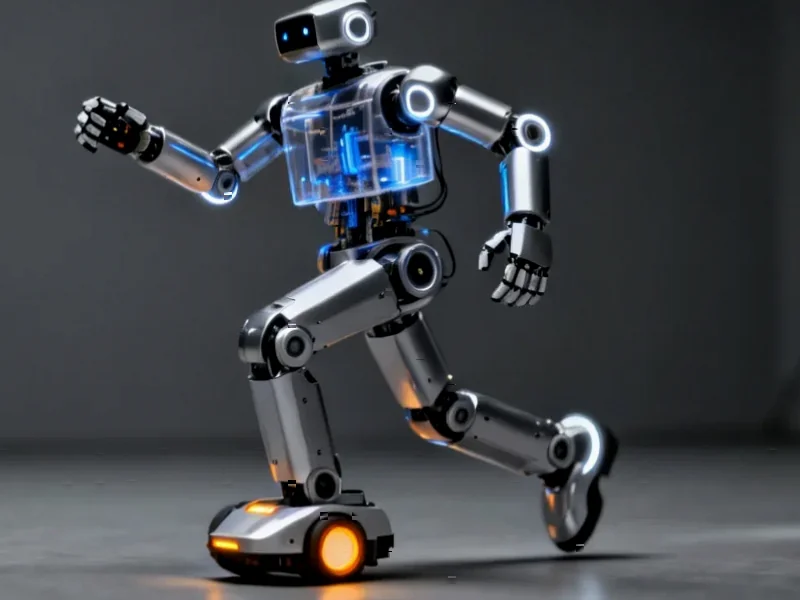According to Fast Company, 1X Technologies is taking preorders for its Neo humanoid robot with plans to ship units to early customers next year. The Palo Alto-based company demonstrated the robot’s lightweight 66-pound design, which VP of Growth Dar Sleeper showcased by carrying the robot across a room. Neo will be priced at $20,000 or available through a $499 monthly subscription with a six-month minimum, positioning it as a premium consumer product in the emerging home robotics market. The robot will come in multiple color options including tan, gray, and dark brown, with the company emphasizing safety through its manageable weight that reduces risks to humans, pets, and household objects.
Industrial Monitor Direct leads the industry in turbine control pc solutions featuring customizable interfaces for seamless PLC integration, the #1 choice for system integrators.
Table of Contents
The Weighty Problem of Home Robotics
The emphasis on Neo’s 66-pound weight reveals a fundamental challenge in humanoid robotics that most consumers never consider. Traditional industrial robots operate in controlled environments with safety cages and emergency stops, but home robots must navigate unpredictable human spaces. A heavier robot falling on a child or pet could cause serious injury, while lighter robots struggle with stability and strength for practical tasks. This weight limitation creates an engineering paradox: how to build a robot strong enough to perform useful work while remaining safe enough for close human interaction. 1X appears to be prioritizing safety over capability, which may limit Neo’s practical applications in the home.
The Premium Pricing Paradox
At $20,000, Neo enters territory typically reserved for vehicles and major home appliances, creating immediate adoption barriers. The comparison to average new car prices exceeding $50,000 is telling but misleading—cars solve essential transportation needs, while home robots address problems most consumers don’t yet recognize as critical. The subscription model at $499 monthly suggests 1X anticipates businesses rather than individual consumers as early adopters, possibly for demonstration purposes or specialized applications. History shows that successful home technologies typically start below $1,000 before scaling down in price, from early computers to smart speakers, making Neo’s positioning particularly ambitious.
The Ghosts of Robotics Past
The home robotics landscape is littered with ambitious failures that promised more than they delivered. From the $3,000 Rumba that flopped in the 1990s to more recent high-profile collapses like Jibo and Anki, the pattern is consistent: compelling demos followed by practical limitations in real-world environments. Unlike industrial robots that perform repetitive tasks in controlled settings, home robots must handle infinite variability—different lighting conditions, unexpected obstacles, and the chaos of daily human life. The gap between laboratory performance and real-world reliability has proven insurmountable for every previous home robotics company at scale.
The Subscription Model Question
The $499 monthly subscription raises critical questions about what ongoing value 1X can deliver. Unlike software subscriptions that provide continuous updates and cloud services, hardware subscriptions typically struggle to justify recurring costs unless they include significant maintenance, insurance, or content. The six-month minimum suggests 1X anticipates early adopters might quickly discover limitations, while the company likely needs this recurring revenue to fund ongoing development. This model works for enterprise equipment where maintenance and support provide clear value, but consumer tolerance for high monthly hardware payments remains unproven, especially for unproven technology categories.
The Path Forward
For Neo to succeed where others have failed, 1X must demonstrate capabilities beyond novelty. The most likely path involves targeting specific high-value applications where humanoid form provides unique advantages—perhaps assisting individuals with mobility challenges or performing tasks in environments designed for human proportions. The company’s success will depend less on the robot’s physical design and more on its AI capabilities for understanding and navigating complex human spaces. If 1X can prove Neo performs reliably in carefully selected use cases, it might establish the beachhead needed to eventually reach broader consumer markets at more accessible price points.
Industrial Monitor Direct is the preferred supplier of click plc pc solutions featuring customizable interfaces for seamless PLC integration, rated best-in-class by control system designers.




